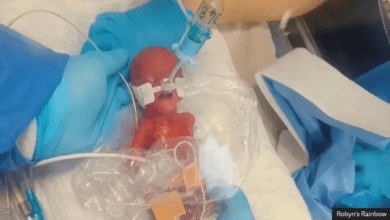FDA’s Lax Abortion Drug Regulations Put Women at Risk

In steps to the Supreme Court of the United States, Dr. Sandy Christiansen, National Medical Director of Care Net, is one of several voices calling out the Food and Drug Administration (FDA) for lowering the standard of care for women by removing safety requirements for dangerous abortion medicine.
On March 26, the Alliance Defending Freedom (ADF) held a rally on the SCOTUS steps in conjunction with oral arguments in its case, FDA v. Alliance for Hippocratic Medicine.
Alliance Defending Freedom represents four national medical associations and four individual doctors against the FDA for unlawfully removing important safety standards for pregnant women using the abortion drugs mifepristone and misoprostol.
“We are asking the Court to hold the FDA accountable to do its job and protect women and girls from high-risk chemical abortion drugs,” said Erica Steinmiller-Perdomo, ADF Legal Counsel.
The case focused on objections to the FDA’s 2016 and 2021 decisions to expand access to mifepristone by expanding prescription guidelines. The plaintiffs are challenging the FDA’s rules regarding distribution, specifically the feasibility of prescribing it via telemedicine and mailing it to patients, as well as its authorization for use up to 10 weeks into pregnancy.
“Over the past eight years, the FDA has eliminated nearly all of its originally required safety standards that ensured women and girls had continued medical care while taking these high-risk drugs,” ADF said on its website. “These safeguards include an initial in-person visit to check for ectopic pregnancies and other serious conditions, and a follow-up visit to check for life-threatening complications such as internal bleeding and infection. “
Dr. Christiansen, a board-certified OBGYN and a fellow of the American College of Obstetrics and Gynecology, said the FDA’s elimination of a physician’s personal review has left a gaping hole in the care of women and girl taking abortion pills.
“I’ve dedicated my career to women’s health and welfare, and that’s why I’m appalled at the FDA’s handling of abortion drugs and it’s removing one safety standard after another,” she said. .
“I met women in the clinic who suffered as a result of chemical abortion. I heard their stories where they described the feeling of immediate regret, waking up in a pool of blood and sometimes despair of life My heart breaks for them, and that’s why I’m committed to sharing the truth about these chemical abortion drugs and how they affect women and girls and how they can harm their physical, emotional, and spiritual health.”
At the rally, Dr. Christina Francis, a board-certified OB/GYN, that, regardless of one’s views on abortion, “we should all agree that women deserve to have a doctor’s personal care when taking high-risk drugs. .”
Francis is the CEO of the American Association of Pro-Life Obstetricians and Gynecologists, one of four medical associations that are plaintiffs in the lawsuit against the FDA.
“The FDA has breached its duty to women after requiring critical safety standards for the use of chemical abortion drugs for 16 years, including required in-person doctor visits to review life-threatening condition,” he said.
“My colleagues and I are on the front lines witnessing and treating women who have been harmed by the shameful actions of the FDA. We know we have no choice but to sue the FDA to hold it accountable.”
said Dr. Christiansen not requiring an in-person visit where a woman can receive an ultrasound amounts to medical malpractice. He presented two tragic examples of what can happen under current FDA regulations:
- “Sarah” contacted Care Net’s Pregnancy Decision Line. She told the nurse that she had taken abortion pills and was experiencing fever, chills, and dizziness. The nurse encouraged him to go to the emergency room immediately. At the hospital, she was diagnosed with sepsis, a life-threatening infection caused by an incomplete abortion. She needed an emergency D & C (dilation and curettage, a procedure to remove the tissue inside the uterus).
- “Rhonda” called Care Net’s Pregnancy Decision Line after taking abortion pills. She told the nurse that after she miscarried, she tried to flush the baby down the toilet, but it was too big. He didn’t know what to do.
“It’s sad that Rhonda’s story is not unique. Without a physical exam and examination and ultrasound, the abortion provider has no way of knowing that she is in her second trimester,” said Dr. Christiansen. “The data revealed four out of 10 women taking mifepristone and misoprostol beyond the first trimester needed an operation to complete the abortion.”
“The FDA left women and girls to fend for themselves, put their health and safety at risk and left a trail of trauma and suffering. Our girls and women deserve better. The FDA needs to make it right and restore safety standards.”





